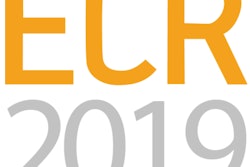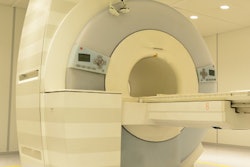
A comprehensive study of diagnostic reference levels (DRLs) in Saudi Arabia has shown that the current levels are comparable with European DRLs, thanks to cutting-edge imaging technology, but patient dose varies between departments depending on scanning mode and protocols used.
Demand for coronary CT angiography (CCTA) is growing in Saudi Arabia in line with global trends associated with the need to identify patients with cardiac atherosclerosis, but there are no published studies on either doses or technologies used for CCTA procedures in the country, and the associated, potentially high, radiation dose involved remains a concern, noted the authors of an article published in Radiation Protection Dosimetry (17 January 2018).
 Ali Alhailiy, PhD.
Ali Alhailiy, PhD."Although there have been several regional DRL studies for pediatric and adult CT chest and abdomen examinations, to date, there have been no national DRL studies conducted for routine CT and CCTA in Saudi Arabia. This is the first time that national DRLs for CCTA in Saudi Arabia have been recommended," said lead author Ali Alhailiy, PhD, CT technologist and academic lecturer at the Faculty of Applied Medical Sciences, Prince Sattam Bin Abdulaziz University in Al-Kharj.
Saudi DRLs for CCTA are comparable or slightly lower than those in European countries, he told AuntMinnieEurope.com. This is possibly because more than 55% of CCTAs included in the study were performed using prospective ECG-gated mode (PGM), which is considered to be the most effective dose-saving technology in CCTA imaging demonstrating Saudi Arabia is at the forefront of evidence-based practice.
| DRLs for CCTA and calcium score test in Saudi Arabia | ||
| Saudi DRLs (75th percentile) | ||
| Scan type | CTDIvol (mGy) | DLP (mGy cm) |
| Mixed modes | 43 | 808 |
| PGM | 29 | 393 |
| RGM | 62 | 1,057 |
| Calcium score | 5.8 | 69 |
Alhailiy added that the DRL values from European studies were defined for both earlier and current CT scanner model technology, but only current technology was included in the Saudi study. The Saudi DRLs now established point to a real need for the results of the study to be disseminated so centers can revise their CCTA protocols.
Comparatively low DRLs
Datasets for 197 CCTAs with a mean weight of 77 kg were analyzed in detail. Some 63.5% of patients were male, reflecting the higher rates of cardiovascular disease and mortality in males compared with females in Saudi Arabia. Of the 197 CCTAs, 108 CCTAs were performed using PGM and 89 using retrospective ECG-gated mode (RGM).
National DRLs for CCTA were defined as the 75th and 25th percentile of median volumetric CT dose index (CTDIvol) and dose length product (DLP). DRL for CCTA were proposed for three groups based on scanning modes used: RGM examinations, PGM examinations, and mixed mode (all scans using both gating modes).
The DRL values for CTDIvol were 29 mGy in PGM exams and 62 mGy in RGM exams, while DRLs for DLP were respectively 393 mGy cm in PGM exams and 1057 mGy cm in RGM exams.
Compared with other reported national DRL values, relatively low values were observed in this study.
| Saudi DRLs compared with other countries | ||
| National DRLs (75th percentile) | ||
| National DRL study | CCTA* DLP (mGy cm) | Calcium score (mGy cm) |
| Saudi Arabia (2017) | 808 | 69 |
| Switzerland (2010) | 1,000 | 150 |
| The Netherlands (2013) | 671 | - |
| Italy (2014) | 1,208 | 131 |
| France (2014) | 620 | - |
| Japan (2012) | 1,510 | - |
| Iran (2016) | 1,073 | 187 |
| PGM and RGM Saudi DRLs compared with European DRLs | ||
| National DRLs (75th percentile) | ||
| National DRL study | CCTA* DLP (mGy cm) | Calcium score (mGy cm) |
| Saudi Arabia (2017) | 808 (PGM) 383 (RGM) 1,057 |
69 |
| Switzerland (2010) | 1,000 | 150 |
| The Netherlands (2013) | 671 | - |
| Italy (2014) | 1,208 | 131 |
| France (2014) | 620 (PGM) 370 (RGM) 870 |
- |
The study showed the 75th percentile of the DLP value was 40% lower than the national DRL values from Italy and Japan, but comparable with those from the Netherlands and France.
The study also revealed wide dose variations across the hospitals surveyed for CCTA; the highest was a five-fold difference in median DLP between centers (169 to 984 mGy cm). These differences were associated with variations in mAs and kVp. Among those centers using PGM, the lowest median DLP was 169 mGy cm.
Voluntary participation
The researchers invited 18 public and private hospitals as well as CT centers across Saudi Arabia to participate on a voluntary basis, sending each center a booklet in which staff could enter protocol and dose data.
Eleven centers (seven public, two university, and two private) completed the survey booklet. Ten hospitals submitted complete CCTA dose information for at least 20 adult patients collected from the RIS and PACS. One hospital submitted data for only 12 adult patients due to the recent installation of a new CCTA scanner and PACS. In total, the team received 197 CCTA datasets from across 11 different CT scanners ranging from 64 to 128 slices. All CCTA examinations for the evaluation of bypass graft patency were excluded as they require a longer scan length than a standard CCTA. No exclusion criteria based on patient weight were applied.
Ahead of the game
In Saudi Arabia, the number of imaging centers that perform CCTA procedures has been continuously growing, as has the number of patients with suspected cardiovascular disease (CVD). A recent Saudi community-based survey revealed the overall prevalence of CVD is 5.5%, which represents the third most common cause of national hospital-based mortality after car accident and senility, according to Alhailiy.
CCTA has emerged, therefore, as a promising minimally invasive tool for diagnosis and management of CVD in Saudi medical practices due to its high diagnostic accuracy and cost-efficacy compared with other imaging modalities such as conventional cardiovascular angiography or even myocardial SPECT tests.
"Saudi Arabia certainly is emerging on the world stage of dose reduction. For this study, we worked with leading researchers at the University of Sydney and our study findings support updating CCTA scanning protocols used in Saudi CT centers to focus on dose optimization," Alhailiy noted.
Because of rapid improvement in CT technology, the CCTA DRL survey should be updated every three to five years and more attention should be paid to calcium scoring tests and the application of dose-saving technologies such as prospective ECG-gated mode and iterative reconstruction algorithms, according to Alhailiy.
"Most Saudi imaging centers are adopting a quality control strategy that plays an important role in dose optimization in general. In particular, I hope this research will trigger protocol updates that reduce dose without compromising the image quality," he said.



















